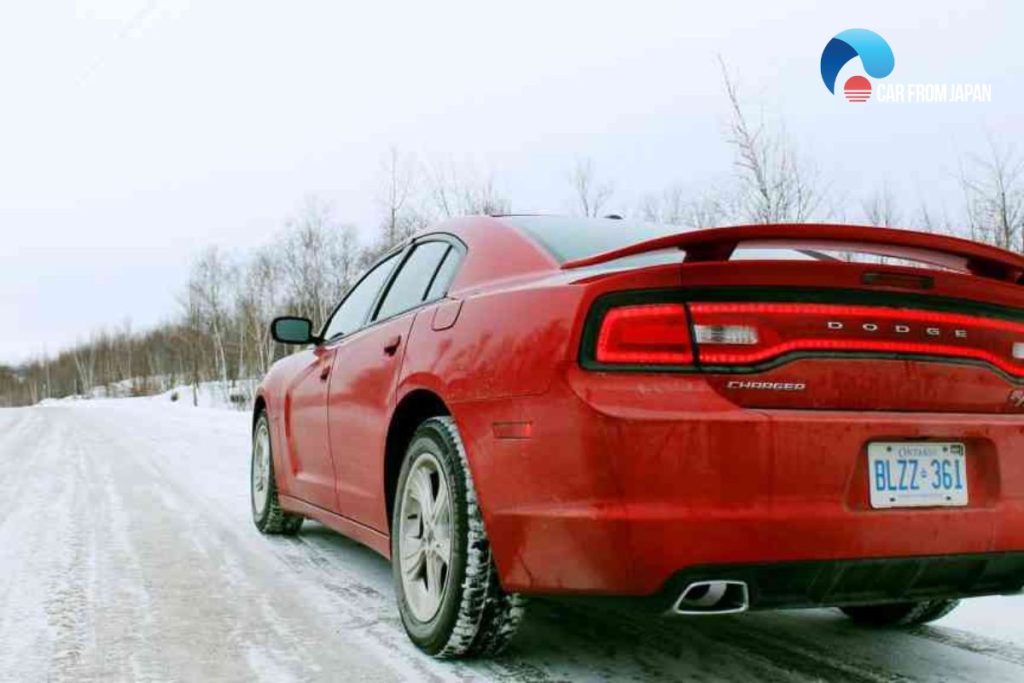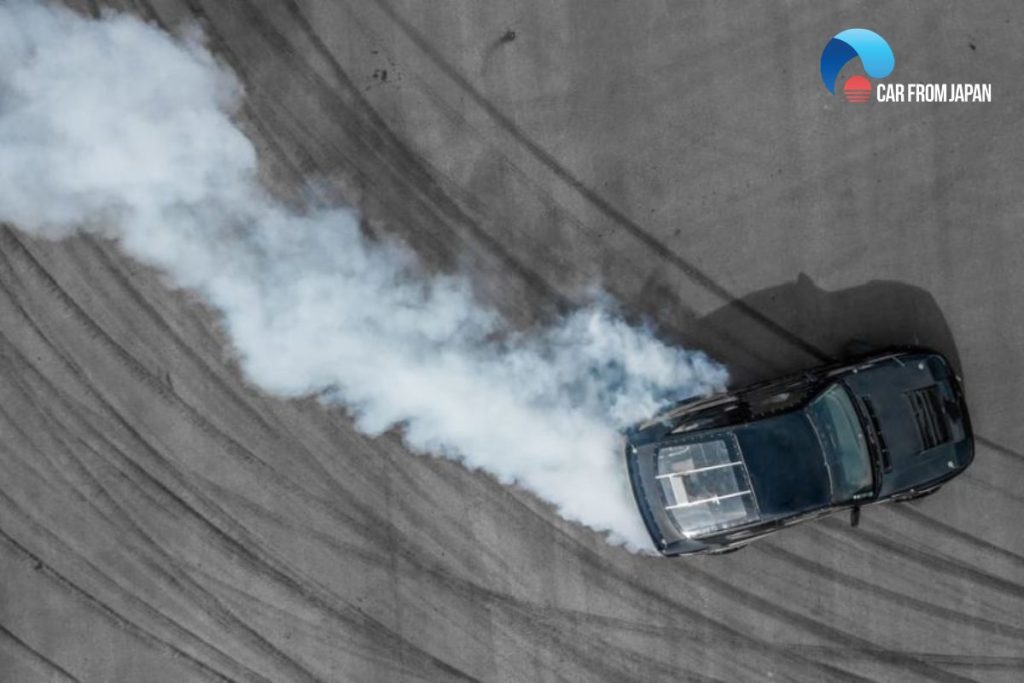Drifting is an art and most people think the feat requires a rear-wheel-drive car with a 1000+ hp engine and a hydraulic handbrake. Wrong!
You can do FWD drifting too. It will take lots of practice, patience, and following proper safety rules. And here’re more details!
Contents
- Can You Drift With FWD?
- How To Do FWD Drifting?
- Key Dangers When You Perform FWD Drifting
- What Are The Safety Cautions For The Front Wheel Drive Drift?
- FAQs on FWD Drifting
- Is drifting with FWD vehicles challenging?
- Can any front-wheel-drive vehicle be used for drifting?
- What modifications are commonly done for FWD drifting?
- What are some tips for beginner FWD drifters?
- What are the differences between FWD and RWD drifting?
- Can I drift in snowy or wet conditions with a front-wheel-drive car?
- Final Words
Can You Drift With FWD?
FWD vehicles and drifting is a match made in heaven. Pretty much anything RWD drifts, from garbage trucks to motorcycles, and omnibuses to even bicycles. For this reason, many people doubt whether an FWD can drift at all.
They drift but this is actually more like a slide in corners and the proper name for this sliding is lift-off oversteer.
Lift-off or snap-oversteer happens when a car corners at high speeds. Due to the shifting in weight from the rear to the front wheels and the friction between the tires, the road cannot provide enough grip and traction through the turn. For this reason, the car begins to slide.
A front-wheel-drive car is likely to understeer when cornering fast, but it will be a different scenario if you let off the throttle. The vehicle’s weight will shift from the rear to the front side, causing lift-off oversteer or FWD drifting.

How To Do FWD Drifting?
Drifting is a driving technique, or a stunt more appropriately, where the driver deliberately oversteers to make the rear wheels or all tires lose traction but without losing control for the entirety of a corner.
The technique will be different depending on whether it is an RWD or FWD platform. You have to use the clutch-kick oversteering for an RWD vehicle while FWD requires the lift-off method.
For performing the drifting, there is no need to drive at crazy speeds. Just enter a corner faster than necessary and follow these steps.
Perform the feign
Accelerate to a high speed that you are comfortable with. Get ready for the maneuver once you are near the corner. Slightly move the wheel, just 5 to 10 degrees of the turn, to the side away from the spot where you want to take the turn.
This slight movement is called ‘feign’ that sends the vehicle to a rocking motion, helping with the correct shifting of the weight once the slide starts.
Take the opposite turn
Just after performing the feign, spin the wheel to 1/4 to 1/3 turn toward the direction you want the car to roll. The direction of this motion will be opposite to the feign.
See More: Can You Drift an Automatic Car?
Start the slide
When turning the wheel, break the rear wheel traction by pulling the handbrake. The car will begin sliding and the rear end will start coming around right away. You have to release the rear brake to stop the slide.
The slide’s length depends on how long you keep the handbrake on. So, you can easily experiment with the slide’s distance.
Control the slide
The last part of FWD drifting is managing the wheel so you can control the length of maneuver and direction of the slide.
To do so, turn the wheel to the direction opposite to entering the slide. Apply the throttle to experiment with the slide and maneuver distance.

Key Dangers When You Perform FWD Drifting
Understeer
The inherent tendency of FWD vehicles to understeer presents a significant hazard in drifting attempts if you are not experienced enough.
This understeer occurs when the front wheels lose traction while cornering, causing the vehicle to continue straight despite steering input.
While FWD drifting techniques aim to induce oversteer (the rear end of the vehicle sliding outwards), the underlying understeer characteristic can suddenly return during maneuvering.
This sudden change from oversteer to understeer makes controlling a slide extremely difficult and can potentially result in loss of control or a crash.
The ability of the driver to anticipate and react to this transition is crucial, but its unpredictable nature makes it a persistent hazard for the average FWD drifter.
Sudden oversteer
In addition to understeering, sudden oversteering is also one of the most significant risks associated with FWD drifting, causing loss of rear-end traction.
This is often caused by improper weight transfer, uneven steering inputs, or improper use of the handbrake or electronic braking technique.
The sudden change from traction to oversteer can catch the driver off guard, making recovery extremely uneasy.
Loss of control due to oversteering often results in a spin, increasing the likelihood of collision with obstacles or other vehicles, especially in tight or confined spaces.
Limited control
The Front wheel Drive drift offers significantly less control and predictability than the RWD one. The front wheels are responsible for steering and provide steering force, making precise adjustments of drift angle and duration less than ideal.
This limited control makes it more burdensome to correct and recover from unexpected changes in vehicle behavior. The reduced ability to accurately control a drift increases the risk of a complete loss of control, potentially resulting in a crash or swerve.
Mechanical stress
Drifting places extreme stress on the drivetrain. The constant changes in weight, traction, and high power output place a heavy burden on the CV joints, transmission, and clutch.
CV joints, in particular, are susceptible to damage due to the extreme angles at which they operate during drifting maneuvers. Transmissions can also wear out quickly due to rapid gear changes and high torque loads.
Likewise, clutches are subject to increased wear due to the frequent engagement and disengagement required when performing some FWD drifting techniques.
When components critical to drifting are at high risk of failure, the danger of this action becomes much more alarming.

Read More: Oversteer vs Understeer: The Differences
What Are The Safety Cautions For The Front Wheel Drive Drift?
Professional instructions
Experienced Drift lecturers can provide appropriate instructions on appropriate techniques, vehicle control, and safety processes for FWD cars.
Drift participants can identify and correct bad habits from the beginning, significantly reducing the risk of accidents.
You should not try to learn FWD Drift only from online videos or unofficial sources because these sources often do not show much basic knowledge to develop the accurate control needed for a safe and effective drift.
Controlled environment
FWD drifting should only be in a controlled environment, such as a closed race or an area reserved for motorcycle sports activities.
This environment must have no obstacles, vehicles, or pedestrians. A large, airy stone area with a good grip is the ideal context to practice vehicle control techniques and drift safely.
These spaces help minimize the possibility of unexpected dangers and allow the driver to focus on developing the necessary skills.
Equipped the car properly
To have a complete drift FWD experience, you need a fully-equipped car with safety standards and mechanisms.
These special vehicles often have upgraded suspension, high-performance brakes, and specialized tires with good control and traction. Moreover, other upgrades, such as limited anti-slip differential (LSD), will also be valid when performing drift.

Safety protection
Arming appropriate safety protection is not negotiable for drift FWD car. The necessary items include specialized helmets, fireproof clothes, and seat belts.
Start slowly
Starting slowly is a good approach when learning drifting. If you enter this approach, you can start with basic car control exercises, such as zigzag driving exercises and figure 8, to better understand the characteristics and handling limits of the car.
Then, when the master starts with the skill, you can absorb more advanced drift techniques when your skills and confidence after the steering wheel are improved.
Observer
The observer will observe around and notify the driver about the potential dangers that may be approaching.
A skilled observer plays a big role in maintaining a safe environment in drift sessions.
Emergency plan
Before participating in any FWD activity, remember to make an emergency plan and clearly state the processing process when losing control or unexpected mechanical failure.
Ensure easy access to fire extinguishers and first aid equipment in the event of an incident. A clear emergency plan can help minimize risks and ensure quick reactions in endangered situations.
FAQs on FWD Drifting
Is drifting with FWD vehicles challenging?
Drifting with a front-wheel-drive vehicle can be more challenging compared to rear-wheel-drive or all-wheel-drive vehicles.
Since FWD vehicles primarily rely on the front wheels for steering and power, maintaining a controlled drift requires precise throttle and steering inputs.
Can any front-wheel-drive vehicle be used for drifting?
While most front-wheel-drive vehicles can be used for drifting, certain factors, such as the vehicle’s weight distribution, suspension setup, and power output, can affect its drifting capabilities.
What modifications are commonly done for FWD drifting?
Common modifications include upgrading the suspension for better handling, installing a limited-slip differential to improve traction, and adding performance tires to enhance grip.
Some enthusiasts also modify the engine for increased power and torque.
What are some tips for beginner FWD drifters?
For beginners, it’s essential to practice in a safe and controlled environment.
Start with slow speeds and gradually increase as you gain confidence. Focus on smooth steering and throttle inputs to maintain control during the drift.
What are the differences between FWD and RWD drifting?
In FWD drifting, the front wheels provide both power and steering, making it more challenging to initiate and maintain a drift.
In RWD drifting, the rear wheels provide power, allowing for more controlled slides and easier drift initiation.
Can I drift in snowy or wet conditions with a front-wheel-drive car?
Drifting in or driving snowy or wet conditions can be possible with a front-wheel-drive car due to reduced traction.
However, it requires careful consideration of safety, as these conditions can be unpredictable and hazardous.
Check out this video from Helpful DIY to learn a basic tutorial on how to drift a FWD car in the snow!
Disclaimer: Be careful when performing the drifting. This blog or the writer does not take any responsibility for any damages or deaths caused by following the drifting technique mentioned in this post.
Final Words
Remember, FWD drifting should be done responsibly and in designated areas with proper safety measures in place.
Practicing drifting in a controlled environment with the right skills and techniques is essential to enjoy the sport while minimizing risks to yourself and others.



